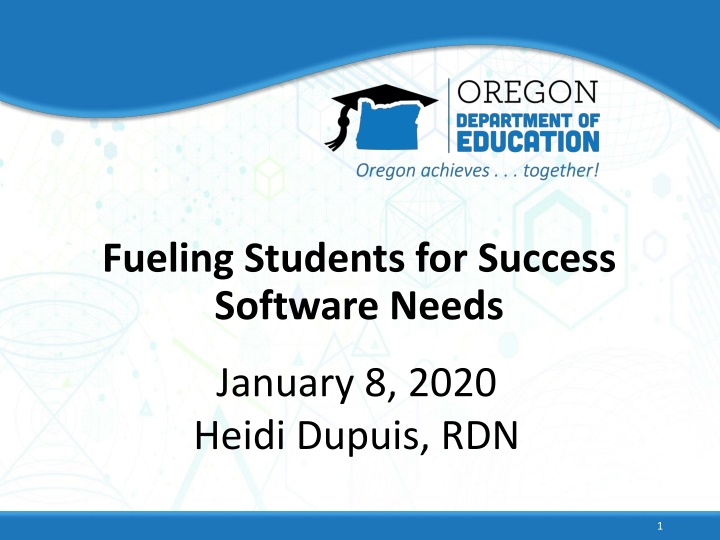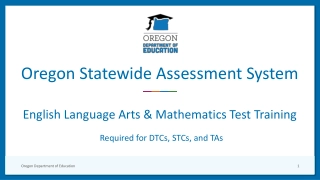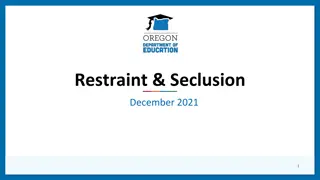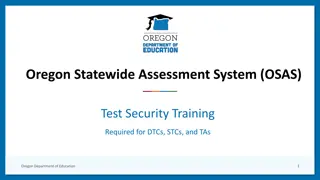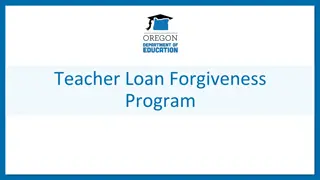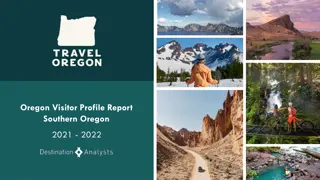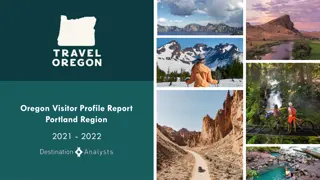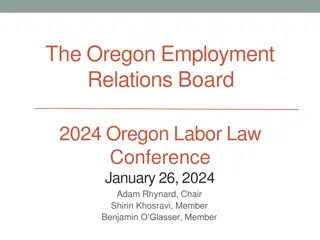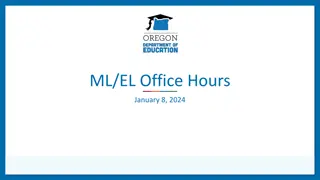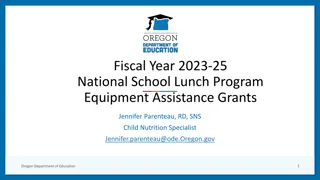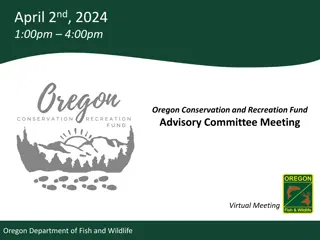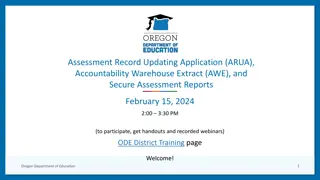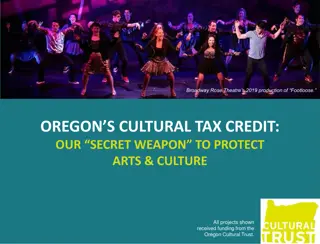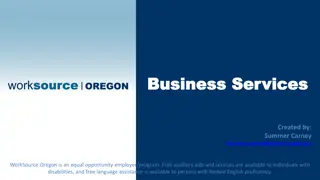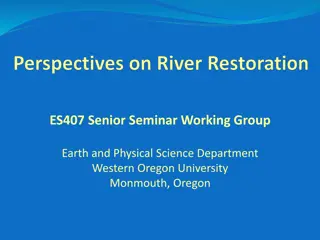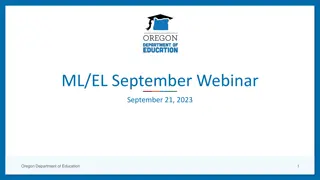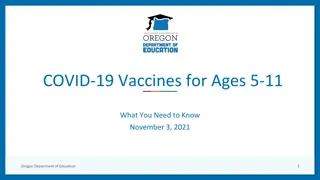Oregon Department of Education Programs and Initiatives
Fueling Students for Success Software Needs by Heidi Dupuis, RDN on January 8, 2020. The Oregon Department of Education focuses on equity and excellence for every learner, striving to provide high-quality, well-rounded learning experiences for over 580,000 K-12 students. Their education equity stance emphasizes fair resource allocation and opportunities for marginalized youth. Initiatives like the Student Success Act support students' development through meals and community programs. Data shows trends in school meal participation, with state-wide funding emphasizing access to meals and breakfast programs.
Download Presentation

Please find below an Image/Link to download the presentation.
The content on the website is provided AS IS for your information and personal use only. It may not be sold, licensed, or shared on other websites without obtaining consent from the author.If you encounter any issues during the download, it is possible that the publisher has removed the file from their server.
You are allowed to download the files provided on this website for personal or commercial use, subject to the condition that they are used lawfully. All files are the property of their respective owners.
The content on the website is provided AS IS for your information and personal use only. It may not be sold, licensed, or shared on other websites without obtaining consent from the author.
E N D
Presentation Transcript
Fueling Students for Success Software Needs January 8, 2020 Heidi Dupuis, RDN 1
Oregon Department of Education Our Why Equity and Excellence for Every Learner The Oregon Department of Education works in partnership with school districts, education service districts and community partners; Together, we serve over 580,000 K-12 students; We believe every student should have access to a high-quality, well- rounded learning experience; We work to achieve the Governor s vision that every student in Oregon graduates with a plan for their future. 2
Oregon Department of Education Education Equity Stance Education equity is the equitable implementation of policy, practices, procedures, and legislation that translates into resource allocation, education rigor, and opportunities for historically and currently marginalized youth, students, and families including civil rights protected classes. This means the restructuring and dismantling of systems and institutions that create the dichotomy of beneficiaries and the oppressed and marginalized. 3
Student Success Act Supporting students physical, social, emotional and academic development by Offering breakfast after the bell and Meals at no charge to most students 4
Oregon Data: 2018-19 Daily Lunch 266,963 out of 580,000 (46 %) School Meal Participation Daily Breakfast 134,603 out of 580,000 (23%) 60% 50% 40% 30% 20% 10% 0% 2008 2009 2010 2011 2012 2013 2014 2015 2016 2017 2018 Breakfast Lunch 5
Funding State-wide Business Revenue Tax Hunger Free Schools Account For 2020- 2021: $41.6 million appropriated $40.1 million for access to meals at no charge $1.2 million for Breakfast after the Bell Equipment Grants $ .3 million for staffing 7
FS2 Initiatives Breakfast After the Bell Breakfast After the Bell Equipment Grant Community Eligibility Provision Incentive Expanded Income Group Program 8
FS2 Implementation Activities Administrative Rule Development Software Specifications Local Program supports Program Agreements and implementation 9
FS2 Initiatives Breakfast After the Bell Breakfast After the Bell Breakfast After the Bell Equipment Grant Community Eligibility Program Incentive Expanded Income Group Program 10
Breakfast After the Bell Applies to schools with 70% of students eligible for free and reduced price meals Breakfast served after the school day starts All students have access regardless of grade or schedule Up to $5,000 for equipment to support change Exempt: 70% of Free and Reduced price students eating Affected: 353 schools, 130,000 students 11
FS2 Initiatives - Community Eligibility Provision Breakfast After the Bell Breakfast After the Bell Equipment Grant Community Eligibility Program Incentive Expanded Income Group Program 12
Community Eligibility Provision At least 40% of students receive SNAP, TANF, FDPIR, Foster, Migrant, homeless, runaway services (ISP) Can group high and low ISP schools to reach 40% Breakfast and lunch at no charge to all students ISP x 1.6 = Free claiming rate 4 year cycle Potential to double number of schools 13
Community Eligibility Provision Incentive 16
Software Needs: Data Elements Community Eligibility Provision Data Elements By Program Year Reimbursement Goal - XX% OR CEP Breakfast Rate - $X.XX OR CEP Severe Need (SN) Breakfast Rate - $ X.XX OR CEP Lunch Rate - $X.XX Site Identified Student Percentage Site Claiming Identified Student Percentage Site Free Claiming Percentage 18
Software Needs: Functionality Claim Value for CEP Incentive Same calculation for Breakfast and Lunch Programs Calculation by program Total Meals claimed X Reimbursement Goal = Goal Meals Goal Meals (Free Claimed meals) = the OR CEP meal count OR CEP Meal count X OR CEP meal Rate = State Reimbursement 19
FS2 Initiatives - Expanded Income Breakfast After the Bell Breakfast After the Bell Equipment Grant Community Eligibility Program Incentive Expanded Income Group Program 20
Expanded Income Guidelines (EIG) Federal Free 130% of poverty and below Oregon Reduced Price 130 185% of poverty Paid Above 185% of poverty Above 185 300% of poverty 21
EIG Methods Application Census Rate of school age children above 185% and up to 300% federal poverty from those above 185%. School district level Applied to paid meal count All Paid meals at no charge ODE establishes income guidelines above 185 and up to 300% Household apply for benefits Meals at no charge for certified students 22
EIG Eligibility by Method EIG by Applications Set paid lunch and breakfast price Certify applications for Income group above 185 300% OR Paid Verify only free and reduced price by federal guideline EIG by Census No Paid meal Price Process eligibility by Federal regulations and guidance Verify approved Free and Reduced price applications 23
EIG Meal Counting by Method EIG by Apps Meals counted into free, reduced price, paid and OR paid categories as certified EIG by Census Meals counted into free, reduced price and paid according to federal regulation 24
EIG Claiming by Method EIG by Apps Meal count reported: Free Reduced price Paid OR Paid Eligibility count for OR Paid OR Paid subset of Paid EIG by Census Meal count reported: Free Reduced price Paid 25
EIG by Apps Reimbursement Federal As approved for additional $.02 and severe need: Free Count X Federal Free rate by program Reduced Count X Federal Reduced Price rate by program Paid Count X Federal Paid Rate by program State OR Paid Count x State Paid Rate by program 26
EIG by Census Reimbursement Federal As approved for additional $.02 and severe need: Free Count X Federal Free rate by program Reduced Count X Federal Reduced Price rate by program Paid Count X Federal Paid Rate by program State Paid Count x Census Rate) = State Supplement meals State Supplement meals X State Paid Rate = State $ 27
EIG Software Needs: Data Elements Expanded Income Group Data Elements By Program Year OR Paid Breakfast Rate - $X.XX OR Paid SN Breakfast Rate - $ X.XX OR Paid Lunch Rate - $X.XX OR 185-299% income guidelines by family size By Sponsor Census Rate - .XXXX 28
EIG Apps Software Needs: Functionality Indicate method of EIG by breakfast and lunch program Approve Applications in the above 185 300 % poverty Count meals served to students certified above 185- 300% Count students certified in above 185-300% Consolidate site claims to a sponsor claim with EIG data Calculate Reimbursements for EIG by Application and EIG by Census Rounding = .1-.4 round down to whole number; .5 - .9 round up to whole number 29
CNPweb SNP Claim Upload Three data elements added at Site record end Count of Breakfasts in OR Paid Category Count of Lunches in OR Paid Category Count of Students certified eligible in OR Paid Category OR Paid data elements 0 if site is using CEP, EIG by Census or federal program only 30
Contact Information Heidi Dupuis, RDN Oregon Department of Education Child Nutrition Programs 503.947.5893 heidi.dupuis@state.or.us Fueling Students for Success Web site Ask your questions through the Collaboration Tool 31
Questions Questions 32
